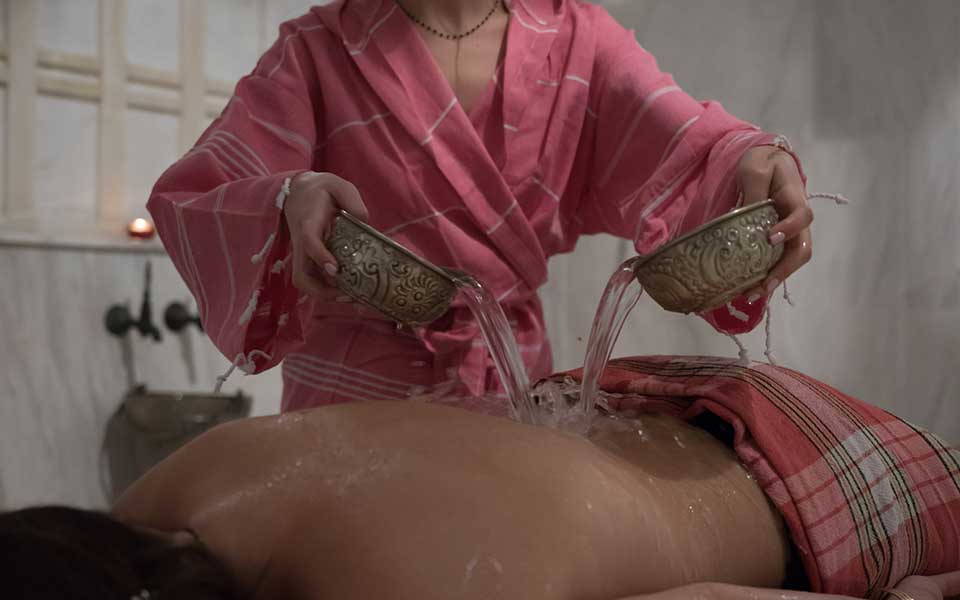Always keen to experiment in order to discover the next big thing in wellness, and a little desperate in my search for ways to rebalance post-lockdown existence, I decided to try three very different treatment types in Athens, each at extremely different temperatures – one steaming hot, one at body temperature and the other at minus 165 Celsius!
What all three have in common is that they are said to offer anxiety and stress relief, physical relaxation and recovery, mental clarity, detoxification, immune system support and a boosted metabolism. Not bad for things that are essentially effortless and enjoyable.
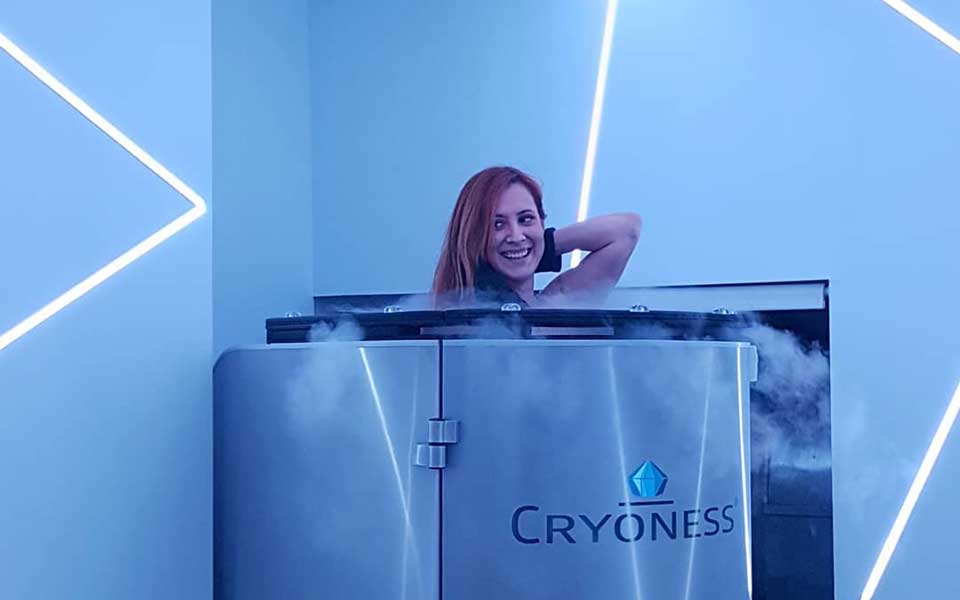
© Ice Tube Crysauna
Ice: Minus 175 Celsius for three minutes
Cryotherapy has nothing to do with crying, (although a good cry can be extremely cathartic and perhaps there should be a new treatment created focused exactly on that).
The word cryotherapy comes from the Greek word for cold “cryo” and “therapia.” Historical documents have shown that cold was used to treat inflammation in ancient Greece and Egypt, and in more recent years has been made famous by the “iceman” Wim Hoff, whose frozen baths and near-naked treks through snowy landscapes have led to a huge trend involving ice baths, cold showers, and a lot of deep breathing.
The benefits
Cryosauna treatment has become more broadly popular in the last decade but was developed as a medical treatment in the late 1970s by Japanese rheumatologist Toshima Yamaguchi for the direct and effective treatment of swelling and pain.
Today, it is widely used by athletes both as they train for a sporting event and afterwards for recovery. However, it has been found to have several other benefits that appeal to a wider audience. Cryotherapy is said to burn calories (between 500-800 in just three minutes), smooth the skin (reducing or obliterating cellulite and small wrinkles), detoxify the organism, boost the metabolism, clear the mind, and create a feel-good buzz by oxygenating the blood and boosting the circulation.
I booked myself in at Ice Tube Cryosauna with great excitement, as it was one of the newer wellness trends I’d read about, and had been eagerly awaiting its arrival to Greece. More of a fan of revitalizing cold than stunting, sweltering heat and being one of those oddballs who’s been practising the Wim Hoff cold shower method rain or shine for over three years, I wasn’t phased by the prospect of the cryosauna.
The process
Stripping down to your underwear, you’re asked to don knee-high woollen socks and gloves provided by the spa and to step into a tubular booth that reaches up to shoulder level. The booth is then filled with nitrogen and air, and you’ll be advised not to inhale too deeply and, if you feel uncomfortably cold, to turn around in a circle and raise your arms in the air. Three minutes is the longest amount of time one is allowed to do cryotherapy, but it’s thought that real benefits (for long-term rheumatic pain, muscular aches or for weight loss) come from having at least 10 sessions, two to three times per week.
Δείτε αυτή τη δημοσίευση στο Instagram.
My experience
The prospect of finally trying cryotherapy (and of burning off the calories from the souvlaki I’d had for lunch and then some) was exhilarating. But when the cabin started filling with the white nitrogen smoke and getting pretty icy at -140 degrees Celsius, I couldn’t help but yelp from the sudden cold. Marika, who was reassuringly on hand to guide me through the experience had told me “You’ll feel revitalized and relaxed,” and I began to think she was a liar.
My bare thighs started to feel like the frosted chicken fillets in my freezer so I circled round, but determined to face the challenge like a pro I agreed to the temperature being further cranked down to minus 165. Before I could consider whether this was actually a good idea, the session was over, and I emerged from the cabin feeling quite exhilarated (Marika had been spot-on) and wanting to go again.
Would I go again?
Yes, but only if I felt I had a serious need to. For those who do, such as Alexandre, a fit runner from France who, when I visited, had just run his first Athens marathon and hopped into the ice chamber right after me, the cryosauna is a blessing. “I’ve done it seven times and I love it. It’s good for the body, muscles and spirit,” he enthused. “And it helps you lose weight!” he added, in what felt like a pointed enough way to make me consider revisiting the following day.
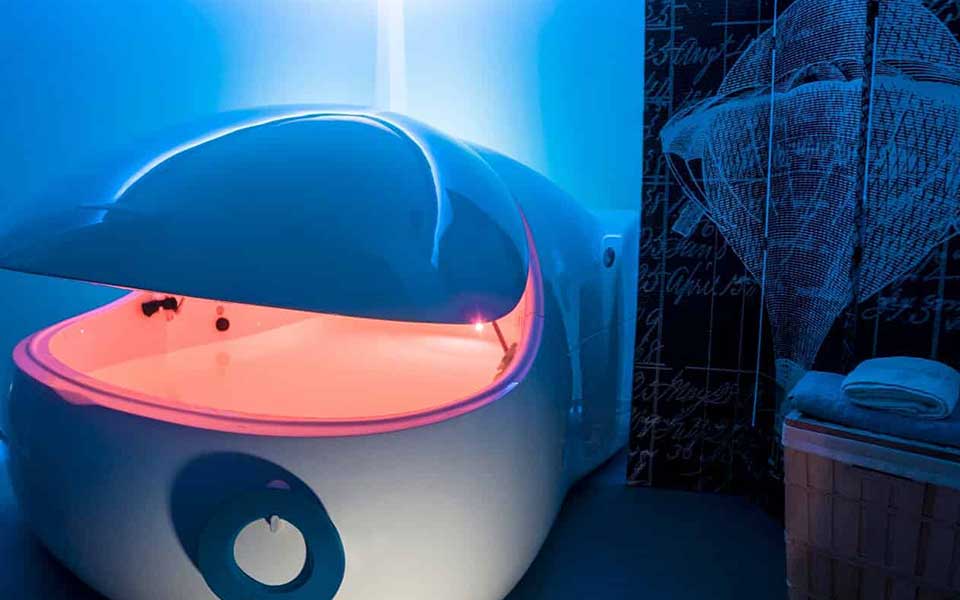
© Etherfloat
Other-Worldly Floatation at Body Temperature
Next came the sensory deprivation tank, which, admittedly, sounds somewhat frightening, but is also scientifically lauded for its numerous mind-body-soul benefits since it was first developed by American neuropsychiatrist and medical practitioner John C. Lilly in 1954.
The benefits
The session involves floating for one hour in water with a super-high concentration of magnesium-rich Epsom salts (which keep you on the surface no matter what), in a sealed pod from where there is no contact with the outer world. Known benefits of floatation are decreased aches and pains, improved sleep quality, mental clarity, sharpened senses and significantly lowered stress levels.
The reason for this is that the experience of floating has been shown, through global studies, to induce the parasympathetic response in the body and nervous system. This, in turn, normally generates a feeling of profound relaxation, in a momentary escape from the world. Consequently, fight-or-flight-inducing cortisol levels plummet, muscles relax (magnesium is known for soothing the muscles) and the mind quietens, taking one into a meditative ‘theta’ state.
“Since lockdown ended, we are regularly booked out,” Karolos, who opened Etherfloat with his cousin Fivos after years of research abroad, tells me, noting that “The most important thing is that floating doesn’t offer what you want, but what you need.”
The process
In a private room, you undress and have a shower (using spa-grade toiletries) and put on a pair of rubber ear plugs that you’ve been supplied with. Then, after having received a step-by-step tutorial in advance, you step into the pod, which looks like a giant white glistening egg out of a sci-fi movie (think “Cocoon”), and close the lid.
Because people may be uncomfortable with the idea of immediately finding themselves in complete darkness and silence, the pod is initially lit up with soft colors, while gentle meditative music plays (tracks can be selected in advance) for around 10 minutes to ease you into the experience. Your 45-minute float follows, but if you’re feeling uncomfortable or need anything you can press a button from inside the pod that notifies the reception to come for assistance, or you can simply open the pod.
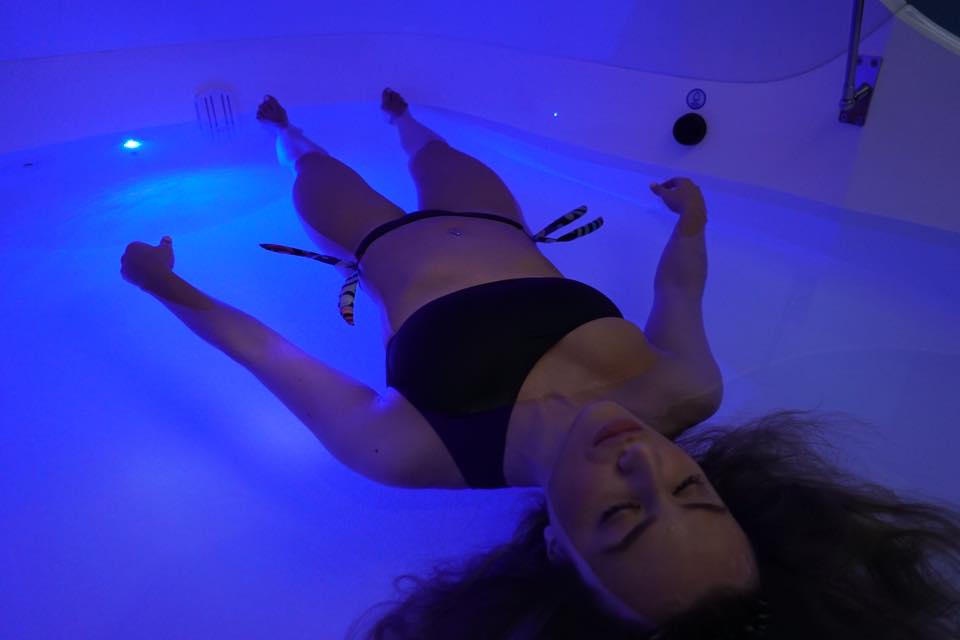
© Etherfloat
My experience
This was my second float experience, the first one having been in the pre-pandemic era, so I generally knew what to expect. However, in my somewhat frazzled post-lockdown state, I was actually almost scared to let go. What would it bring out in me? But as I started to enjoy the feeling of weightlessness and luxurious seclusion, I found myself focusing on my breath, and then drifting off to a peaceful state between sleep and wakefulness. At some point, my heart rate accelerated when I thought that I was probably already halfway through my session and would soon need to return to non-floaty reality, but then I let myself surrender again and revel in a sense of gratitude for the experience.
Would I go again?
I left the session feeling physically light and mentally serene. One session can be a soothing experience, but regular visits are thought to lead to long-term results, so I’m keen to do more of them. Especially upon discovering from Karolos that since my last visit a few years earlier, Etherfloat now also offers pre-float massage therapy.

© Al Hammam
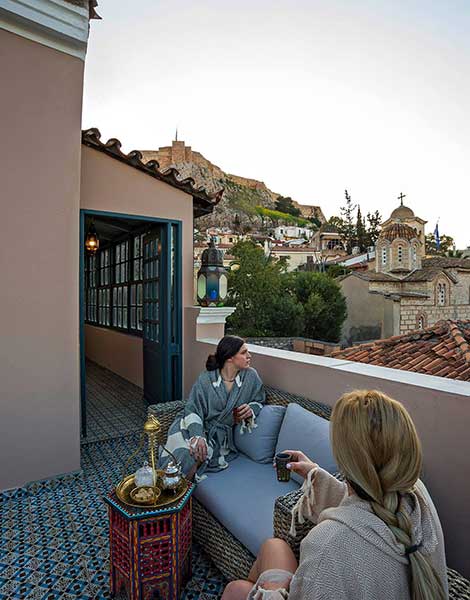
© Al Hammam
Steam, Sweat, Foam and Buckets of Water
Originating in Hellenistic and Roman times, and reintroduced to Greece during the Byzantine period, bathhouses were a feature of Mediterranean culture that became widespread throughout the Islamic world in the 7th and 8th centuries.
The benefits
Over the centuries the steam in the hammam bathhouses was shown to aid in the purification of the body (helpful for overall detoxification through sweating and clearing the respiratory system through inhalation). This, in combination with the use of cold-water rinses during the steaming session, to further enhance purification (by boosting circulation and oxygenating the blood) made the experience a therapeutic one, especially together with intensive scrubbing treatments and oil massage carried out once the muscles are relaxed from the heat.
The process
Al Hammam adheres to traditional practices, using customary Turkish hammam accessories and ingredients. Changing into a peshtamal towel, you sit or lie in the octagonal marble steam room for at least 15 minutes, using a brass bowl that can be filled with cold water at one of the taps around the room to cool off whenever you please.
You can follow this with a traditional-style massage or scrub session in the next door marble steam room or in the dry room upstairs, where a broader range of modern treatments are on offer, such as Athletic, Hot Stone, Chocolate and Olive Oil & Raki. After the experience, you change into your clothes and are invited to a scenic terrace under the Acropolis to sip tea and munch on Turkish delight.
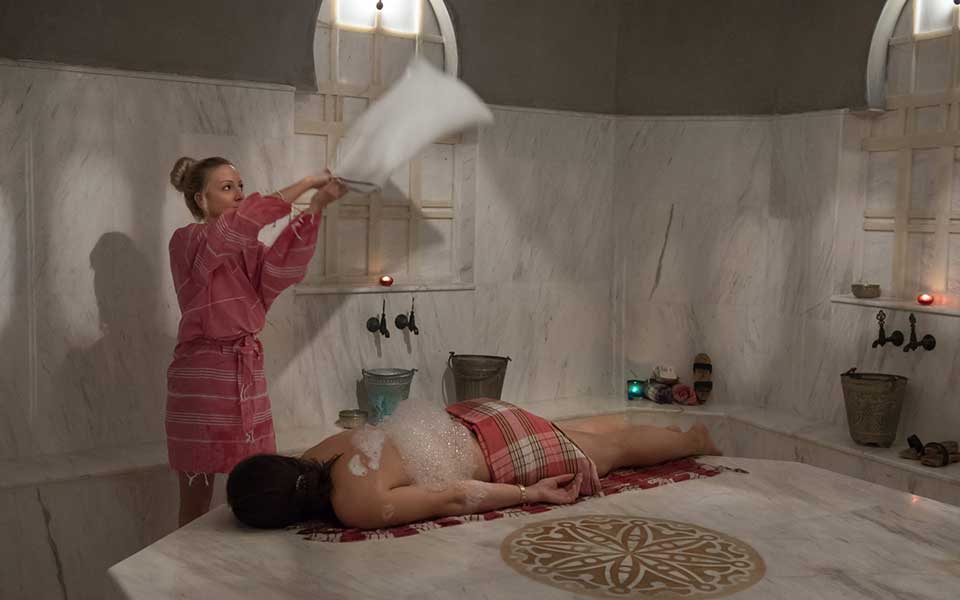
© Al Hammam
My experience
Not a huge fan of intense heat, as mentioned above, I lay in the steam room (where I was fortunate to be alone at the time) for 10 minutes, getting up to rinse off several times. I then alerted the staff I was ready for my treatment, exotically called “Sultan’s Daughter Wedding Hammam” and lay out on a large marble slab. Using black soap and an exfoliating kese glove, the petite yet incredibly strong therapist scrubbed my body from head to toe, front and back, making me feel both pampered and squeaky clean. I then enjoyed being rinsed with water that was poured over me like buckets of rain on a hot summer’s day.
The next part was the best, as the therapist repeatedly dipped a silk pillowcase into a bucket filled with olive oil-rich soap, which she waved around creating giant clouds of foam that she layered over me. It’s probably the closest anyone can get to feeling like they’re inside a cloud. She then proceeded to use the oily foam to offer me a full body massage that left me blissfully relaxed. After that, she washed my hair with a rich almond oil soap and slathered my face in a chocolate mud mask, which she left to infuse for 15 minutes.
Would I go again?
Having a hammam is an indulgent, feel-good treat, and one that can be enjoyed solo or ideally, in the good company of a partner or friend. My skin felt smooth and glowy for days after, and as I walked out into the streets of Plaka, there was a new bounce in my step. I would definitely go again for a special treat.

